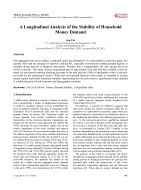A Longitudinal Analysis of the Stability of Household Money Demand
A Longitudinal Analysis of the Stability of Household Money Demand
Abstract
Past aggregate time-series studies, conducted under the assumption of a representative economic agent, frequently show that the demand for narrowly defined M1, especially non-interest-yielding demand deposit, is unstable during periods of financial innovations. Whether this is longitudinally the case among life-cycle savers is unclear. This study utilizes longitudinal data to take another look and find that volatility in the demand for non-interest-earning checking accounts in the mid and late 1990s is attributable solely to the portion held for the transactions motive. When the conventional Baumol-Tobin model is extended to include human capital and family formation variables representing the life-cycle motive, equilibrium money demand is a stable function of both economic and demographic variables.
Others in Series
Working Paper
Working Paper
Working Paper




